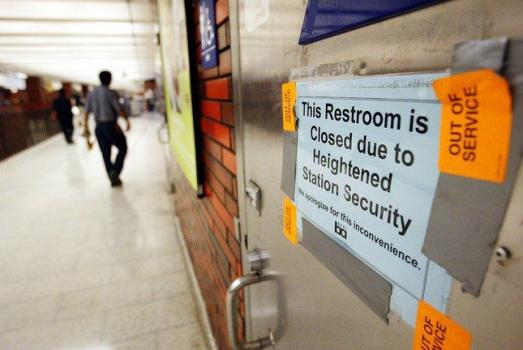For over 20 years, the restroom at BART’s Powell Street station in downtown San Francisco remained shuttered.
That changes on Wednesday when BART unveils a fully remolded bathroom adorned with white tiles and two stainless steel toilets – to the relief of passengers who have been scrambling for somewhere to go at one of BART’s busiest stations.
This week’s reopening comes after a years-long push from some BART board members to reopen bathrooms as riders have had to hold it in anticipation. The pilot program, which will also see Oakland’s 19th Street station bathroom reopened on February 25, is nearly four years behind initial projections.
The restrooms were closed for security reasons in the aftermath of the September 11, 2001, terrorist attacks along with eight other underground stations in Oakland, San Francisco, and Berkeley. While above-ground bathrooms quickly reopened, BART, citing federal guidance, said the underground bathrooms’ ventilation system could be a staging ground for an attack.
Meanwhile, elevators and escalators became notorious havens for public urination.
“It’s time for these bathrooms to reopen,” said Kuro Kurosaka, a BART user in Berkeley. He keeps a mental map of the best places to access toilets outside BART stations during his trips into San Francisco. In recent months he started a Facebook group advocating for restroom access.
“It’s been on my mind for a while,” added Kurosaka. “When (President) Biden called back the military from Afghanistan I thought the war is over – and the bathroom is still closed.”
The new Powell Street facility is an all-gender bathroom stall using a design similar to modern airport restrooms, with no door separating the restroom from the station to prevent users from locking themselves in. There is a hand-washing sink located outside the bathroom and during a pilot stage an attendant will staff the facility, which is scheduled to be cleaned six times a day.
Powell Street is among BART’s most-used stations currently serving over 450,000 riders each month, about 30% of pre-pandemic ridership numbers.
BART board President Rebecca Saltzman has advocated for reopening the bathrooms for over five years, pushing against previous BART management and other board members who were reluctant to get the toilets flushing again. She said that along with legitimate security concerns bureaucratic “inertia” has kept the restrooms closed.
“There was so much focus on keeping the system running and there was less focus on things that were thought of as little,” she said. “But all these things add up.”
Reopening all the closed restrooms is expected to take at least until 2026 and cost $14 million, although the BART board has yet to allocate all the funds and the system faces a looming fiscal cliff as ridership tanked during the pandemic.
Bathrooms in the Lake Merritt station in Oakland and Montgomery station in San Francisco are next to reopen later this year followed by Embarcadero and Downtown Berkeley in 2023. Last on the list is the restroom renovation in the 24th Street station in San Francisco’s Mission District, which will finish in 2026 if BART sticks to the current timetable.
When it comes to restroom access BART does have wider coverage than many of its peers with 41 of 50 stations having public restroom access, although the current bathroom closures are concentrated in BART’s most highly trafficked stations. By comparison, the New York City subway system has around 75 operational restrooms for over 470 stops, which prior to the pandemic were known for their “horrific” conditions, and have remained closed since the start of the COVID-19 lockdowns.
Kurosaka said he expects to use the restroom next time he passes through Powell Street station, but he is worried that vandalism and cleanings will disrupt the service. “Their bathrooms are not very reliable,” he said. “It is very inconvenient.”




















